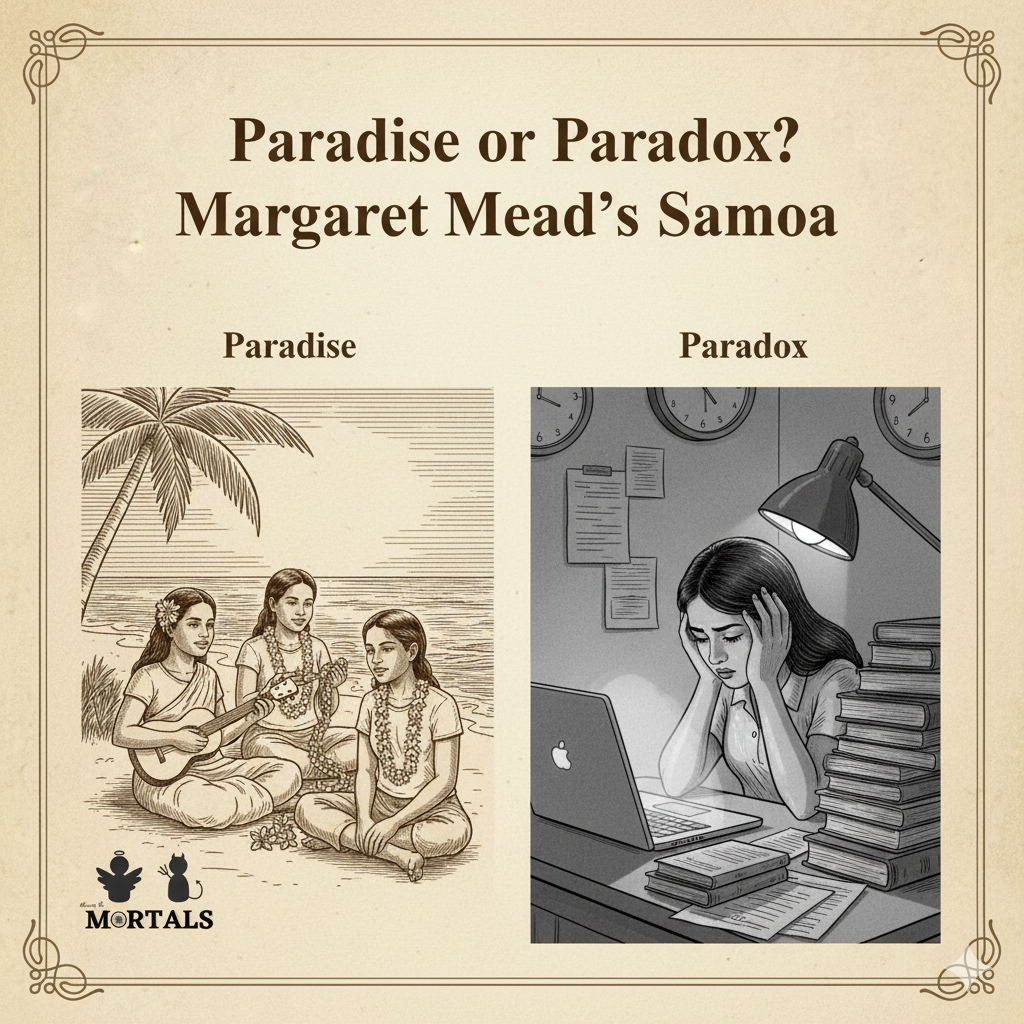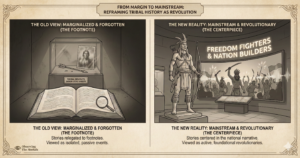Is the emotional turmoil of teenage years—the rebellion, the anxiety, the angst—a universal, biological fact of life? Or is it a unique product of our modern, high-pressure society? In 1925, a young and brilliant anthropologist named Margaret Mead journeyed to the remote islands of Samoa in the South Pacific to answer this very question. Her findings, published in a sensational bestseller, would shock the Western world and ignite a debate that continues to smolder in anthropology to this day. This case study explores Mead’s groundbreaking research, which championed the power of culture in shaping our most intimate experiences.
The Information Box
Syllabus Connection:
- Paper 1: Chapter 2.1 (Culture), Chapter 2.5 (Socialization), Chapter 6 (Anthropological Theories: Culture and Personality School)
Key Concepts/Tags:
- Margaret Mead, Coming of Age in Samoa, Nature vs. Nurture, Culture and Personality, Derek Freeman Controversy
The Setting: Who, What, Where?
This study was the work of Margaret Mead, a pioneering American anthropologist and a student of the legendary Franz Boas. Her findings were published in her 1928 book, Coming of Age in Samoa, which became an international phenomenon. Her fieldwork was conducted in the mid-1920s, focusing on the lives of adolescent girls on the island of Ta‘ū in American Samoa. Mead was a central figure in the Culture and Personality School, which sought to understand how individual personalities and psychological traits were shaped by broad cultural patterns.
The Core Argument: Why This Study Matters
Mead’s work was a direct challenge to the biological determinism of her time. It was a powerful argument for the primacy of nurture over nature.
- The Research Question: Mead was sent to Samoa by her mentor, Franz Boas, with a clear mission: to determine if the difficult “storm and stress” period of adolescence experienced by American teenagers was a universal human trait (nature) or a product of a specific cultural environment (nurture).
- Mead’s Findings – An Adolescent Paradise: After studying 68 adolescent girls, Mead came to a stunning conclusion. She argued that Samoan adolescence was a smooth, peaceful, and relatively stress-free transition into adulthood. She attributed this to several key aspects of Samoan culture:
- A Relaxed Attitude: Life was less competitive and individualistic than in America.
- Diffuse Family Structures: Children were raised by a wide network of kin, so emotional bonds were less intense and fraught with conflict.
- Openness about Sexuality: Most famously, Mead argued that Samoan society had a casual, permissive attitude towards sex. Casual pre-marital sexual relationships were portrayed as common and accepted, leading to a lack of the guilt, shame, and frustration that plagued American teens.
- The Explosive Conclusion: Mead’s verdict was clear: teenage angst was not a biological inevitability. It was a cultural product, created by the sexually repressive, competitive, and choice-burdened society of the West. If we wanted to fix the problems of our teenagers, she implied, we should look to changing our culture, not their hormones.
The Anthropologist’s Gaze: A Critical Perspective
Mead’s work, while iconic, is also the subject of one of anthropology’s most famous and bitter controversies.
- The Freeman Debunking: In his 1983 book, anthropologist Derek Freeman launched a full-scale assault on Mead’s work. Having conducted his own extensive research in Samoa, he argued that Mead’s findings were completely wrong. He portrayed Samoan society as rigid, competitive, and deeply puritanical, where female virginity was highly prized and pre-marital sex was a matter of great shame. He famously claimed that Mead, a young and naive researcher, had been the victim of a hoax, with her young female informants playing pranks on her.
- The Mead-Freeman Controversy: This sparked a massive academic war. Most anthropologists today take a middle path. They acknowledge that Mead’s fieldwork was relatively short and she may have romanticized Samoan life, downplaying its harsher aspects to make her cultural point. However, they also critique Freeman’s work as being equally biased, overly aggressive, and selective in its use of evidence to tear down a celebrated icon.
- A Methodological Wake-Up Call: The true legacy of the controversy was that it forced the discipline of anthropology to become far more self-aware and rigorous. It raised critical questions about fieldwork methods, the reliability of informants, the potential for researcher bias, and the immense complexity of representing another culture.
The Exam Angle: How to Use This in Your Mains Answer
- Types of Questions Where It Can be Used:
- “Critically discuss the Nature versus Nurture debate with anthropological examples.”
- “Explain the key contributions of the Culture and Personality School.”
- “The work of Margaret Mead has been both celebrated and critiqued. Discuss.”
- Model Integration:
- On the Nature vs. Nurture Debate: “Margaret Mead’s classic study, ‘Coming of Age in Samoa,’ is the quintessential argument for the primacy of nurture. She contended that the emotional turmoil of adolescence was absent in Samoa due to its relaxed cultural attitudes, suggesting that this life stage is shaped by culture, not universal biology.”
- On the Culture & Personality School: “The Culture and Personality school sought to link broad cultural patterns to individual psychological development. Mead’s work in Samoa, for instance, attempted to connect the culture’s permissive attitude towards sexuality with a stress-free adolescent experience among its girls.”
- To offer a critical view: “While foundational, Mead’s Samoan research became the subject of the famous Mead-Freeman controversy, which questioned her findings and methodology. This debate, while contentious, was crucial for anthropology as it highlighted the complexities of fieldwork and the need for greater methodological rigor and self-awareness.”
Observer’s Take
The enduring power of Coming of Age in Samoa lies not in whether every detail was correct, but in its revolutionary impact. Margaret Mead’s work was a powerful blow against the rigid biological determinism of the early 20th century. She showed that anthropology could hold a mirror up to our own society and reveal that our ways of living, feeling, and struggling are not inevitable natural laws, but are products of the cultural choices we make. The controversy that followed only strengthened the discipline, reminding us that the quest to understand humanity is a complex, self-correcting, and never-ending dialogue.





